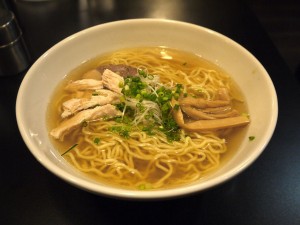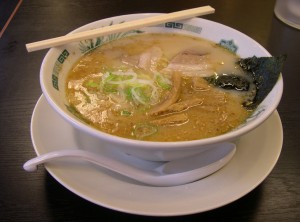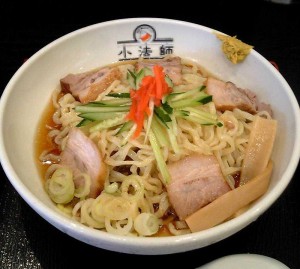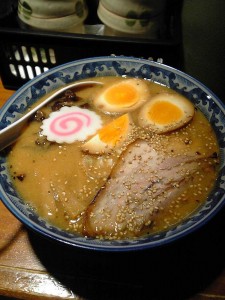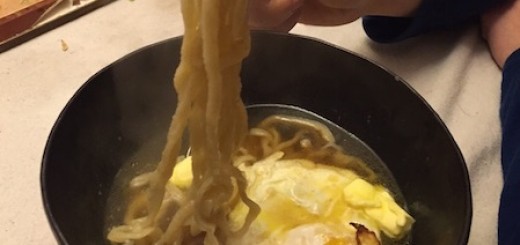Natural History of Ramen Noodle
Ramen is one of the simplest forms of delicious food, but also one of the most affordable and beloved foods, at least in Japan. So, what is ramen? Where does ramen come from? How does ramen become one of most popular foods in Japan?
Although there are variations of ramen in nearly every region in Japan, mostly it just consists of three basic components: fresh noodles, steaming broth and flavoring sauce. The noodles are made from wheat flour, salt, water and some form of alkaline salt that raises the noodles pH, usually gives the noodles yellowish color, slippery texture and enhanced chewiness. Often you would find ramen with less alkalinity is served in the south and west of Japan, and ramen with a higher percentage of alkaline salts in the north and east of Japan. The noodles can be straight, curly, fat or thin. The soup broth is usually made by simmering or hard-boiling the combination of meat (chicken or pork bones including feet, back, ribs, knuckles), seafood (clams, dried sardine or bonito and dried kelp), and vegetables (onions, green onion, ginger, garlic). The flavoring sauce usually differentiates the taste of ramen and adds the umami excitement and salt. Soy sauce, miso and miso are two of the many flavorings used.
The origin of ramen is not very clear. From the Chinese sounding name “ra-men”, it is mostly of Chinese origin. The name of ramen can be traced from a Chinese worker called Wang Wencai, who always shouted “hao la” (Ready!) after making the dish. According to Barack Kushner, the writer of Slurp! a social and culinary history of ramen , “Focusing on ‘la,’ which could have been heard as ‘ra,’ Japanese customers might imitate and demand some of the ‘la’ noodles. “men” terms for noodles, is the Japanese equivalent of the Chinese mian” (Kushner, 268). Ramen could also come straight from Chinese La Mian that has been served in the country for hundreds of years. Here, “La” means to pull or stretch, that is the hand-making process involving taking a lump of dough and repeatedly stretching it to produce many strands of thin, long noodles. This “La” method might be too complicated and too much to be adopted by the Japanese, so they chose the much simpler way of folding-rolling-cutting to make noodles from a wheat flour dough.
George Solt, the writer of Untold History of Ramen, says in his book ” Ramen began life in Japan as a cheap, scrumptious and filling food from China” (Solt, 5). Although the noodles could be introduced into Japan from China as early as Tang dynasty and Song dynasty (690-1279), as Japanese learned and brought back many things from China during that period. The modern version of noodles was actually brought to Japan by Chinese immigrants from the Guangdong region who began working as cooks at restaurants in the port city of Yokohama during 1880s. At early the stage, the noodle soups were mainly consumed by the workers and students from China (more than 100,000 Chinese came to Japan to study between 1896 to 1938). From the beginning of 1910s, Japanese restaurants started employing Chinese cooks and transforming the Chinese noodle soup into a hearty and rich food. They added roasted pork, pickled bamboo shoots, soy sauce, eggs etc., all of which had never been used in the Chinese noodle soup. With the expansion of wheat and meat production, along with the surge of industrial economic development in the first half of the 20th century, Japanese ramen was made into a an affordable part of Japanese daily life. Ramen finally got Japanese workers, solders and students into restaurants, consuming it regularly.
During 1940s, the Asia/Pacific War diverted manpower and resources away from food production in Japan and put the whole nation into famine with bad harvests. Ramen almost disappeared in Japan due to this food crisis. After the war, the U.S. military occupied Japan for seven years and sent lots of wheat to Japan as an effort to minimize starvation and prevent violent, hungry uprisings. The time was perfect for ramen noodles. Ramen made from American wheat became a success and got so popular that they took over some of rice’s share of the Japanese peoples’ staple starch habits. In addition, the invention of instant ramen in 1958 by a Taiwanese man named Ando Momofuku, led to a food revolution. Ramen started to take over the traditional patterns of diet and became the food of choice for many. The marketing of Cup Noodle led to ramen’s internationalization.
In Kushner’s telling, there are over 200,000 ramen restaurants in Japan now, as well as a wide range of ramen-related museums, musics and books. Ramen is surely the national food in Japan, and now gaining more and more popularity around the world. People in Paris, London, New York, London, Shanghai, Hong Kong have access to the most tasty hand-craft ramen noodles. There are ramen shops even in Dubai, Brazil and South Africa.
As I finished my ramen noodles research, I started wondering- are our food choices truly our personal choices? or are they a combination of political and economic choices made by others? Why is ramen getting more and more popular around the world nowadays? I am looking forwards to finding out the answers.
Works Cited
Brickman, Sophie. 2014. “The History of the Ramen Noodle.” The New Yorker, May 21. http://www.newyorker.com/culture/culture-desk/the-history-of-the-ramen-noodle.
Kushner, Barak. Slurp!: A Social and Culinary History of Ramen – Japan’s Favorite Noodle Soup. Leiden: Global Oriental, 2012. Print.
“Ramen.” 2016. Wikipedia, the Free Encyclopedia. https://en.wikipedia.org/w/index.php?title=Ramen&oldid=708151376.
Solt, George. The Untold History of Ramen: How Political Crisis in Japan Spawned a Global Food Craze. 2015. Print.

